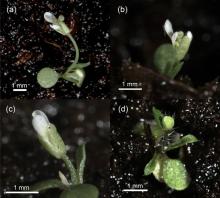The FLOWERING LOCUS T like 2–1 gene of Chenopodium ficifolium and Chenopodium quinoa acts as a strong activator of flowering in Arabidopsis, triggering flowering at cotyledon stage and causing lethality when overexpressed.
The FLOWERING LOCUS T (FT) gene is the essential integrator of flowering regulatory pathways in angiosperms. The paralogs of the FT gene may perform antagonistic functions, as exemplified by BvFT1, that suppresses flowering in Beta vulgaris, unlike the paralogous activator BvFT2. The roles of FT genes in other amaranths were less investigated. Here, we transformed Arabidopsis thaliana with the FLOWERING LOCUS T like (FTL) genes of Chenopodium ficifolium and found that both CfFTL1 and CfFTL2–1 accelerated flowering, despite having been the homologs of the Beta vulgaris floral promoter and suppressor, respectively. The floral promotive effect of CfFTL2–1 was so strong that it caused lethality when overexpressed under the 35S promoter. CfFTL2–1 placed in an inducible cassette accelerated flowering after induction with methoxyphenozide. The spontaneous induction of CfFTL2–1 led to precocious flowering in some primary transformants even without chemical induction. The CqFT2–1 homolog from Chenopodium quinoa had the same impact on viability and flowering as CfFTL2–1 when transferred to A. thaliana. After the FTL gene duplication in Amaranthaceae, the FTL1 copy maintained the role of floral activator. The second copy FTL2 underwent subsequent duplication and functional diversification, which enabled it to control the onset of flowering in amaranths to adapt to variable environments.

